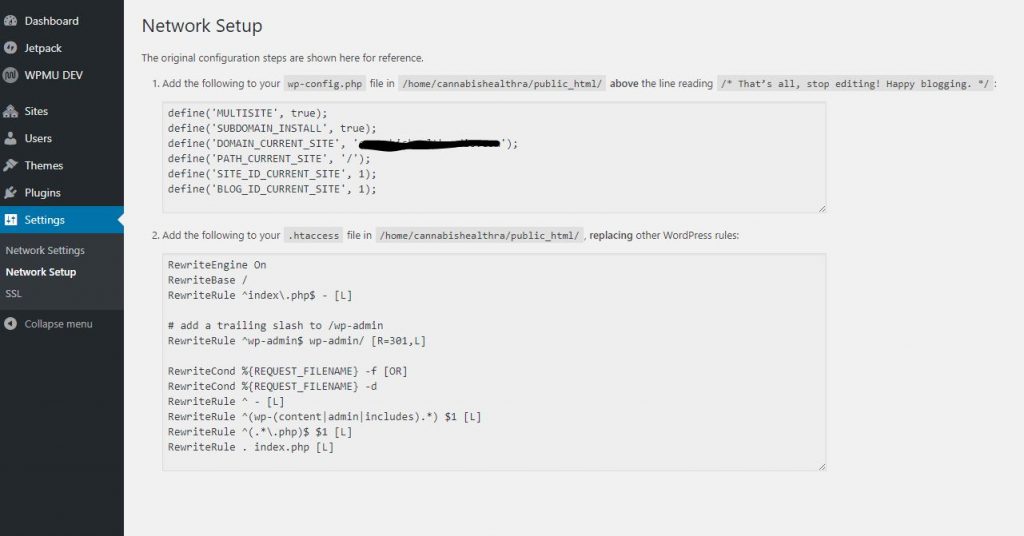HOW TO SET UP WORDPRESS MULTISITE WITH SUBDOMAINS (FORMALLY WMPU)
FOR SSL AND DNS RESOLVING
This walkthrough will teach you how to get WordPress Multisite with subdomains to function correctly and to have the server issue your autoSSL certificates.
Last Update:
When you install WordPress using Softaculous and select WordPress Multisite (WMPU), the default configuring is to use subfolders. This configuration is the easiest as it doesn’t require any special DNS settings or extra configuration in cPanel to issue SSL certificates.
However, if you change your existing WordPress installation to Multisite, you have no choice but to use Multisite with subdomains. To get each subdomain to resolve and to have SSL certificates issued for those sites, there are several steps you need to take for this all to work.
Step 1: Switch Your WordPress Installation to WordPress Multisite With Subdomains
To do this, you need to edit you wp-config.php file and your .htaccess file.
Step 1a: Via your FTP client (we recommend Filezilla), open the ‘public_html’ folder.
Step 1b: Download both the .htaccess and wp-config.php files.
Step 1c: CTRL+C, CTRL+V in a different folder than your download location to create a backup just in case something goes sideways.
Step 1d: Open the wp-config.php file in a text editor. We recommend Notepad++.
Find the line that reads:
/* That's all, stop editing! Happy blogging. */;
directly above that line, add the following:
/* Multisite */ define( 'WP_ALLOW_MULTISITE', true );
Step 1e: Log into your WordPress dashboard.
Step 1f: In the ‘My Sites’ menu in top-left corner, go to ‘Network Admin -> Dashboard’.
Step 1g: Then, go to ‘Settings -> Network Setup’. There you will find additional instructions to finish the set up process for WordPress Multisite with subdomains.

Step 1h: Create your first subdomain by going to ‘Sites -> Add New’ in the Network Admin dashboard.
Step 2: Configure DNS Settings in cPanel so that the Subdomains Can Be Visited (DNS Resolving)
These steps add a Wildcard record to your DNS Zone on the server so that any subdomain.yourdomain.com will be directed to the correct place. If the subdomain hasn’t been set up in your Network Admin settings, then it will return a 404 error.
Step 2a: Login into cPanel.
Step 2b: Scroll down to the ‘Domains’ section and click ‘Subdomains’.
Step 2c: In the ‘Create a Subdomain’ area, enter the following:
Subdomain: *
Domain: Make sure the domain that has the WordPress Multisite installation is selected. If not, choose it from the dropdown menu.
Document Root: Remove the default and replace it with ‘public_html’. Changing the document root location is very important if you want your subdomains to function correctly.
Click ‘Create’.
Changes to DNS can take up to 48 hours to propagate across ISPs, so please be patient after you complete this step. You’ll know that it’s working when you enter the first site you created in Step 1h in your browser and it loads successfully.
Step 3: Create Additional Subdomains in cPanel to Have SSL Certificates Issued for Each Site in Your WordPress Multisite With Subdomains Installation
Because the main site on your WordPress network will be https, all your subdomains will be automatically created as https. You won’t be able to visit the public-facing site(s) without getting a security warning until the server issues the SSL certificate.
For the server to know an SSL certificate needs to issued, you need to add the subdomain(s) in cPanel.
Step 3a: Login into cPanel.
Step 3b: Scroll down to the ‘Domains’ section and click ‘Subdomains’.
Step 3c: In the ‘Create a Subdomain’ area, enter the following:
Subdomain: The name of the subdomain you created in Step 1h.
Domain: Make sure the domain that has the WordPress Multisite installation is selected. If not, choose it from the dropdown menu.
Document Root: Remove the default and replace it with ‘public_html’. Changing the document root location is very important if you want your subdomains to function correctly.
Click ‘Create’.
Step 3d: Wait for the server to do its nightly check for new domains for your SSL certificate to be issued, or email Skookum Monkey support to have it issued immediately.
If you decide to wait, you can check on the SSL status in cPanel by scrolling down to the ‘Security’ section and clicking on ‘SSL/TLS Status’. You can ignore the self-signed warning for the Wildcard domain you created in Step 2.
Step 3e: Repeat Steps 3a – 3d every time you add a new subdomain to your WordPress network.
If you have any questions about these steps, please do not hesitate to email Skookum Monkey Support.
Or, hire Skookum Monkey Hosting and Design to install WordPress Multisite with subdomains for you.
WordPress Installation Service
Want to learn more about our services or book your free consultation?

